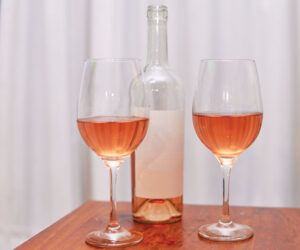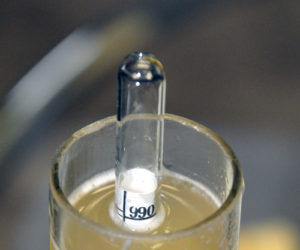
Q
Recently I had an inquiry from a diabetic in regards to the amounts of carbs, sugars and calories in dry white and red wines made from concentrated kits. In calling the manufacturers, they were unable to answer these questions, even after talking with their chemist. In this day and time, more folks are interested in this data. Could you possibly shed some light to this inquiry? Your answer will be greatly appreciated.
Tom Burgiss
Laurel Springs, North Carolina
A
Your question is a good one and one that is easily answered. Whether made from a kit, from non-grape fruit or made from grapes, a typical 5-oz (approximately 150-mL) glass of dry red or white wine with an alcohol content of 12% typically has about 100 calories and between 1.5–3.0 grams of carbohydrates (as tallied by proponents of low-carb diets such as Dr. Atkins). The number of calories and carbs will change based on the alcohol percentage of the wine and the amount that you drink. An easy calculation to find out how many calories you imbibe is to take the alcohol percentage (always listed on the label of commercial wines), multiply it by the number of ounces you are drinking and multiply this by 1.6. For example, if you’re drinking 5 ounces of 12% ABV wine, you’ll be consuming approximately 96 calories.
All of the calories in wine come from carbohydrates. Most of these carbohydrates from dry wine are in the form of ethyl alcohol. A much smaller percentage of the carbohydrates and calories could come from straight, unfermented sugar, as a wine perceived as dry can contain between 0.2–0.4% unfermented sugar. There are many kinds of wines out there and to accurately count the number of calories per glass of wine, you have to know some of the chemical stats about it. However, the “100-calories per glass of dry wine” rule is a good general guideline. If the kit wines you’re making still have significant amounts of unfermented sugar, then you need to take this into account when assessing your dietary needs or giving advice to others. For more information on alcohol, carbs and low-carb diets, please refer to: www.wine.about.com/library/weekly/aa061603.htm.

Q
I bottle my wine in recycled bottles and give much of it away. A friend who is on the receiving end is critical of my choice in color type and size when bottling. I use whatever bottles I have for reds and whites — tall and skinny or short and fat, green, frosted, clear or blue — as long as they seal. Is there an unwritten rule on bottles that I’m missing, or should I remove him from my freebie list?
Jeff Hauenstein
Findlay, Ohio
A
You certainly have heard the old axiom about never looking a gift horse in the mouth — unfortunately your friend has not! The same is true for any freely given wine and I’m saddened by the fact that your friend is moved more by the somewhat-outdated rule of wine-bottling than by gratitude for a thoughtful gift. You are right to consider taking someone off your gift list if they cannot be a gracious recipient.
As I hint above however, there are some bottle-type conventions that some commercial wineries follow, more for the sake of tradition than scientific reason. There are four main bottle shapes that are, in the North American continent at least, named by the types of wine that have traditionally been put in them. The two most widely used are the “Burgundy” and “Bordeaux” bottle. The Hock and Champagne shaped bottles take second place in popularity. A note about locale-specific names: Referring to a wine as “Burgundy” or “Bordeaux” is appropriate only when the wine itself is actually from those regions in France. Thus, calling a wine from California “California Burgundy” is not only a misnomer but is, in fact, internationally illegal.
As French winemakers are various bastions of tradition themselves, the distinctive bottle shapes they chose for their regional products centuries ago continue to be associated with their place of origin. Today, the French along with everyone else buy their wine bottles from international glass suppliers. I have yet to hear a complaint about using French winegrowing regions in description of bottle types.
The “Burgundy” bottle shape has pronounced, but sloped shoulders. When persuing the supermarket shelves, one usually finds Chardonnay and Pinot Noir (the classic varietals of Burgundy) bottled in this shape. It is also increasingly being used for Syrah, Viognier, Pinot Blanc and other popular grape types. The glass color traditionally associated with this bottle shape is called “dead leaf green” and when empty, will display an olive, gold or green hue.
A “Bordeaux” bottle is the well-known, tall, imposing “shelf-shouldered” bottle in which most Napa Valley Cabernets or Bordeaux-type blends are bottled. For reds, the glass color is a dark, forest or antique green. White wines (Sauvignon Blanc is one of the famous white grape types of Bordeaux) are very often bottled in clear (or “flint”) glass.
Hock and Champagne bottles are the next common bottle shapes. One can often find sweet or dessert wines bottled in the Hock bottle. Hock is an old name for German wine, specifically that from the Rhine Valley area. After the 1600s, when Germany figured out that the aromatic and acidic Riesling did the best in this region, Hock became synonymous with a Riesling-based, sweet wine. Though we don’t use the term to describe wine anymore, it has come down to us through the centuries in reference to its traditional container. The Hock bottle shape is much taller than it is wide and has a consistent, bordering on triangular, slope from the bottle lip all the way down to the base. The glass color is most often antique green or brown but lurid hues of bright green and blue are considered traditional for this shape.
The familiar Champagne bottle is the heavy bottomed, thick-lipped, dark green bottle used for the world-famous beverage. The Champagne bottle shape is the only one that has a compelling scientific justification behind it. It has thicker glass and a high punt (the indentation on the bottom of the bottle) that makes it structurally sound and able to withstand the five atmospheres of pressure (usually present in Champagne or sparkling wine).
Thus, your friend is somewhat correct in mentioning that there are (or were) traditions in regards to bottling. Modern home winemakers, however, and commercial winemakers alike, are no longer limited to these traditional bottle shapes. The respective bottle types mentioned were the only options available to the wine producers of each winemaking region — and this was two centuries ago!
For more of the Wizard’s wisdom, pick up the latest issue of WineMaker now available at better home winemaking supply retailers and bookstores.







